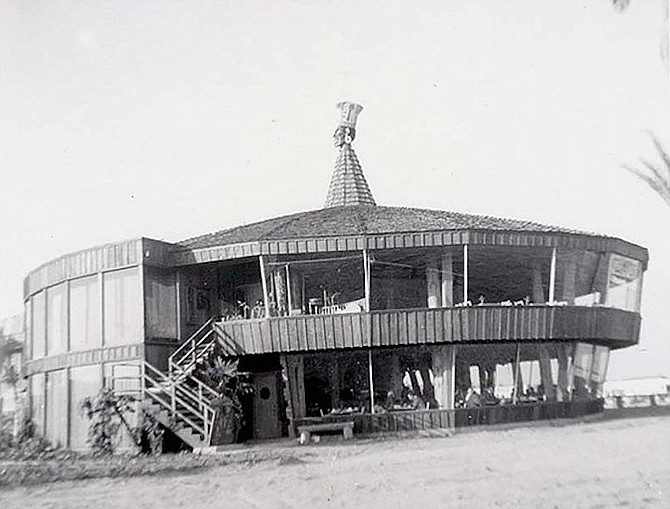
Christian's Hut, 1954
- “Special Tables for Spies, Espionage Agents to View the U.S. Fleet — Binoculars furnished to U.S. Citizens only,” said a 1950s advertisement for the restaurant. Dressed in one of his famously flowered Hawaiian shirts, Ham would work the room, greeting Navy brass and yeomen sailors as they imbibed and watched warship flotillas sail past in the bay and Navy fighter jets arriving and departing from North Island’s runways. (October 22, 2014)
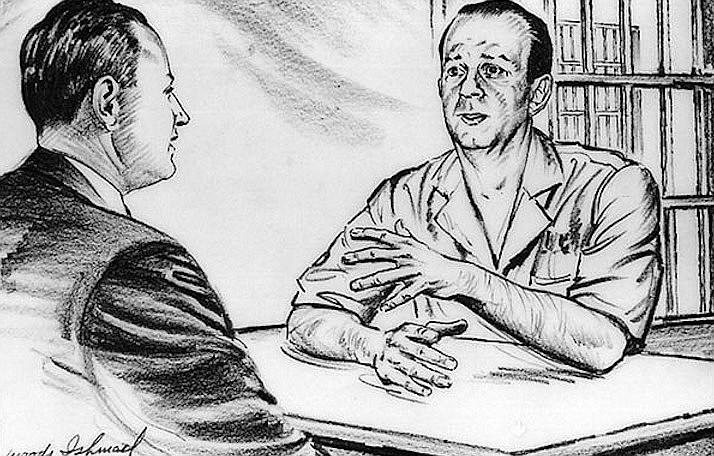
Illustration of Rabbi Silverman (left) meeting with Jack Ruby by Woodi Ishmael.
- Silverman gingerly puts down his cane and eases into a chair for yet one more take on the truth. He is 89 years old, but his memory of November 1963 is still firm, if sometimes, as might be expected at his age and after so long a time, wavering on some of the details. If anyone can speak with authority about those tragic days in Dallas, he can. (November 20, 2013)
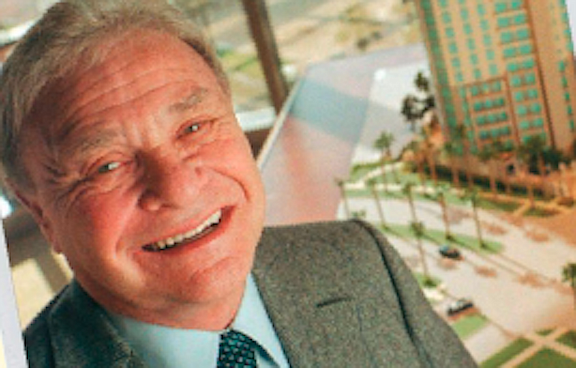
Irwin Molasky in 1999
He is the man who helped build a greater part of Las Vegas with millions of dollars from Jimmy Hoffa’s mobbed-up Teamsters’ pension fund. Along with his close friend and business partner, the legendary Moe Dalitz, an early associate of Detroit’s notorious Purple Gang — high school dropouts who built their fortune on murder, hijacking, and rum-running during Prohibition — he built Paradise Development, a firm that prospered mightly during the heyday of the Vegas mob. Now he is working for the FBI. (June 29, 2011)
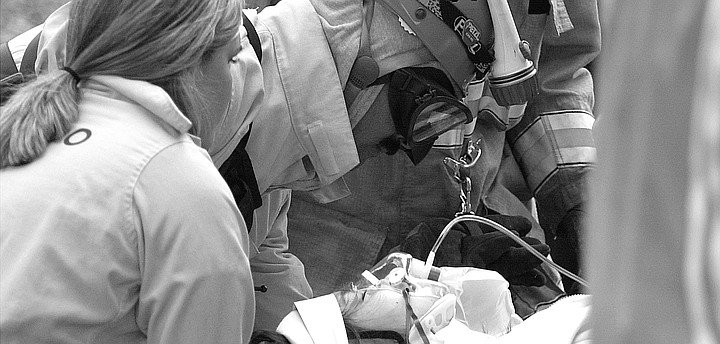
"What ambulances can do is give you saline to keep up your blood volume, but they can't actually provide you with blood."
- A small Illinois biotech company cuts a deal with UCSD. The university agrees to test a substitute for human blood on comatose patients — victims of gunshots and car crashes — without the patients' consent. Within the city of San Diego, the experiment is targeted at several neighborhoods south of I-8, where many poor and minority residents are unlikely to have heard of the study and unlikelier still to have the resources to sue if something goes awry. (July 28, 2005)
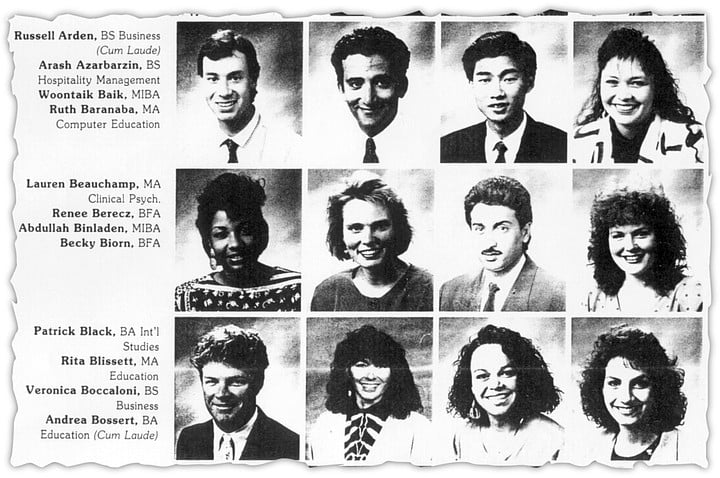
1990 USIU class photo. Binladen second row, third from left. The school catered to wealthy students from Saudi Arabia, Kuwait, and other Middle Eastern countries.
- What McKinney didn't know was that, according to records filed with the San Diego County Recorder's Office, one of the two partners in U.S. Denmar was Abdullah M. Binladen. A man listed as Abdullah M. Binladen, currently listed as having that same address, has been identified as the half-brother of Osama bin Laden, now the world's most wanted man. (October 25, 2001)
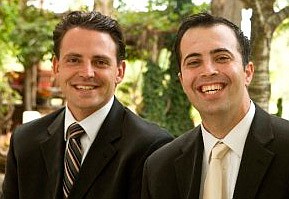
Nathan with his half-brother, Navy Lt. Jonathan Farley
- It is June 2011, and Nathan Fletcher, a 34-year-old California assemblyman and candidate for mayor of San Diego, is speaking at his campaign kickoff.“Let me tell you how I got here,” he says to the crowd standing in a conference room at a biotech company in La Jolla. “I grew up in a blue-collar family. My dad was a factory worker." (May 23, 2012)
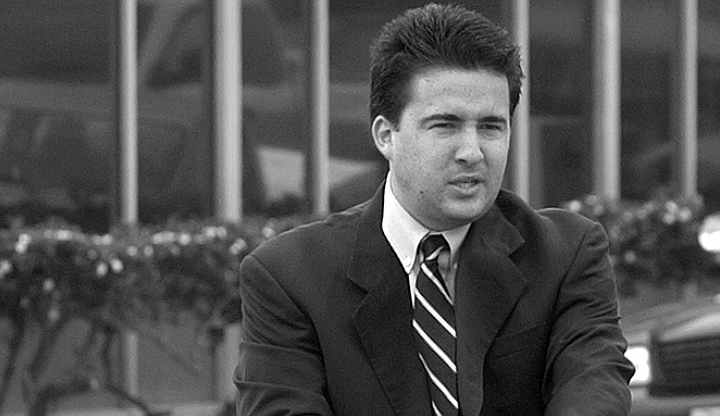
Inzunza, feeling the heat generated by the May 14 raid by FBI agents on the city hall offices, released what he said were two years' worth of personal appointment calendar entries.
- Virtually every business day at the stroke of 12 noon, the 34-year-old councilman can be seen strolling out of his 12th-story city-council office, heading off to one of a chosen few downtown eateries and watering holes, such as Dobson's and the Grant Grill. Two hours later, he returns. But there has always been a nagging curiosity about what goes on in between. (July 31, 2003)
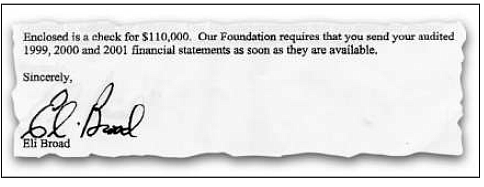
Letter from the Broad Foundation to Essential Information, 10/2/00
- By the time the campaign was over in November 2000, the two foundations — along with the likes of Padres owner John Moores, Wal-Mart heir John Walton, downtown real estate mogul Malin Burnham, and Qualcomm founder Irwin Jacobs — poured $720,000 into a slashing campaign of television spots, attacking Zimmerman and her opposition to the policies of San Diego Unified School District superintendent Alan Bersin. (Oct. 24, 2002)
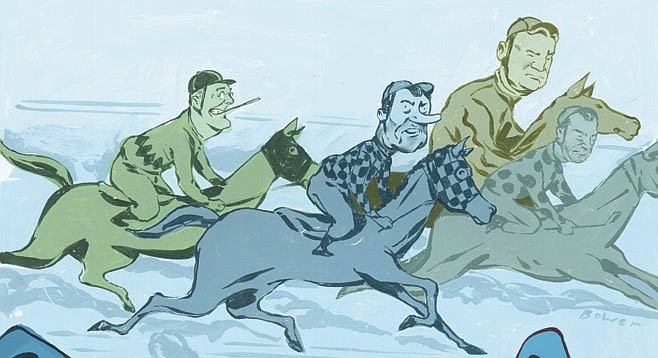
“Serious citizens in La Jolla tend to feel that Hotel del Charro is a Texas enclave."
- No outsider ever actually knew who owned the hotel, for it was held by a Nevada corporation, Rancho del Charro, Inc. (the name was later changed to Hotel del Charro, Inc.). But the real owners were widely understood to be Clint Murchison and Sid Richardson, two Texas oilmen with an interest in everything from racetracks to uranium for use in the atomic bomb. (January 5, 2011)
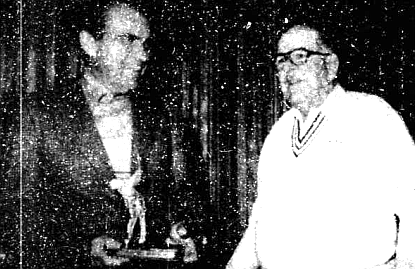
Nixon with Frank Fitzsimmons, Hoffa's designated successor, at La Costa, 1975
- You enter the spa through oversized oak doors and immediately see sun stream down on a naked old man as he climbs out of a sunken Jacuzzi tub in the center of a brightly lit atrium. Nearby, wrapped in herb-scented towels, sits a trio of tanned younger men, engaged in conversation. Around the corner, in a long, darkened, corridor-like room lined with leather-upholstered reclining chairs, a solitary figure, draped in white wraps, gets a facial from an attendant. (November 18, 1999)
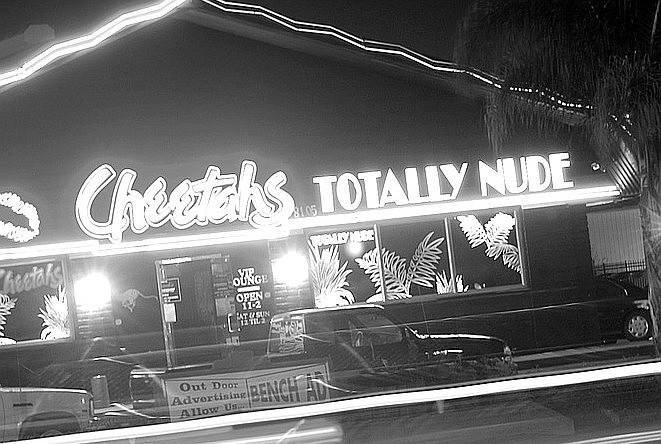
Toni Atkins and Jim Madaffer, two city council aides, collected sizable contributions from employees and dancers at Cheetahs.
- A little more than a year ago, the San Diego City Council passed a new law banning lap dancing and various other forms of what McIlvenna considers artistic expression at the city's strip clubs. Since then, those in the local nude-dancing industry say, business has plunged sharply at many of the clubs, with one prominent exception: Cheetahs, a flashy strip joint in Kearny Mesa. (May 2, 2002)
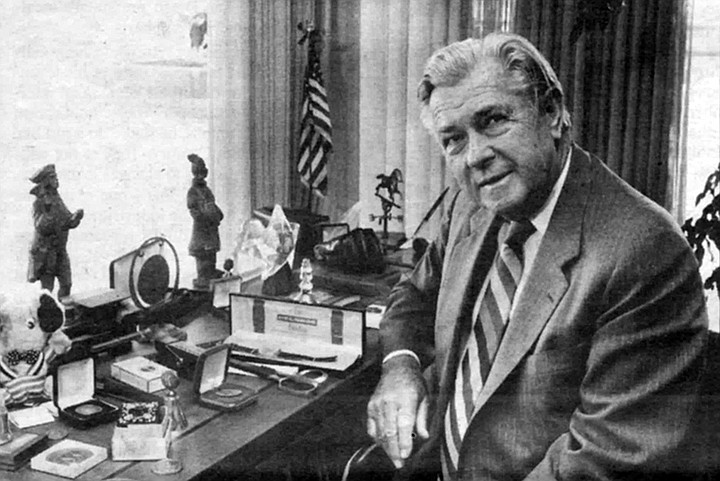
Herb Klein: "I don’t think there are many other contracts in San Diego that have included a ten percent increase.”
- Like Marty Walsh, Herb Klein, editor in chief of the Copley newspaper chain, also remembers the golden era of American daily newspapers. And he says that the grand old business of Colonel McCormick, E.W. Scripps, William Randolph Hearst, and Jim Copley will never be the same. (Mar 22, 1990)

Pete Wilson was Helen Copley’s Richard Nixon.
- Copley purchased both the San Diego Union and the Evening Tribune in 1928. Not all that much had changed about San Diego during the intervening three decades since his original visit. It was still a rough-hewn Podunk place, catering to vice-seekers, hooch-smugglers. (Feb 28, 2008)
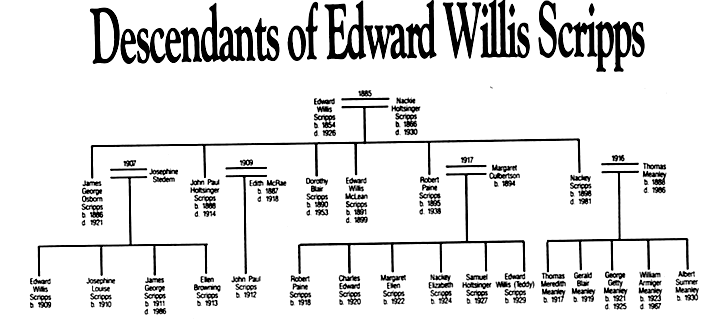
The future of Scripps Howard will soon be in the hands of the twenty-eight heirs of Robert Scripps.
- Sixty-six years ago, Edward Wyllis Scripps, the premier newspaper baron of nineteenth-century America, sat aboard his yacht the Ohio, which lay in the still waters off Jacksonville, Florida. On that day in 1922, he took pen in hand and deprived all but one of his children of the legacy of his vast media empire. By then his relationship |with his wife and family had so deteriorated that he was forced to desert Rancho Miramar, the sprawling 2100-acre ranch he had blasted out of the dusty scrub country north of San Diego. April 7, 1988)

Mr. and Mrs. Clifford Graham, July 1967. "Kathy Graham could sure spend that money. They bought Bing Crosby’s old ranch out there in Rancho Santa Fe, Rancho Osuna, and Cliff totally remodeled it for her."
- The hills of La Jolla have long been full of thieves and liars. Cliff Graham was a classic of both genres. Compact, red-headed, with bulging biceps, he was admired by his ski buddies for his bravado, intelligence, wit, and ability to milk cash from schemes that ended up losing money for everybody but himself and his friends--and sometimes even they got screwed. (Oct. 24, 1996)
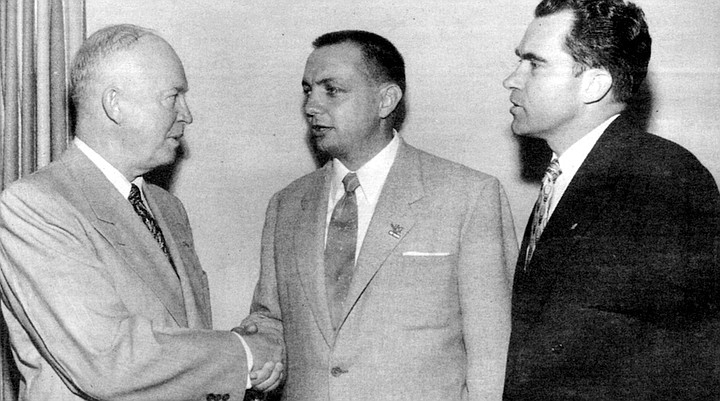
General Dwight Eisenhower, Bob Wilson, Nixon, c. 1952. Copley to Nixon: "I tried this Berlin idea on Bob Finch and Bob Wilson this weekend."
- In the days following the death of Richard Nixon, a series of reminiscences about the battered political warrior began to appear in the pages of the Union-Tribune. Editor Jerry Warren, once a Nixon press aide, wrote that Nixon had resigned the presidency not because he was about to be impeached but because Nixon believed “that the presidency, and America’s standing in the world, had to be protected. He could not prolong the trauma of Watergate.” (July 28, 1994)

John Davies
- This is a story about John Garfield Davies, a wealthy and influential man known vaguely, if at all, by the public. It is also a story about some of his friends, one a powerful land developer and another the mayor of San Diego. Hard work, diligence, enterprise, and connections all play a role here. In combination, they tell a mostly private saga of the accumulation of great wealth and quiet power. (April 8, 1982)
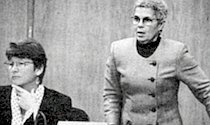
Barbara Warden, Valerie Stallings. Stallings celebrated that the people didn’t get to vote on it.
- In the last nine or ten months — they signed the deal with the Chargers about two and a half years ago, and we did our referendum last December — the city council has done absolutely nothing to make any inquiry of the Chargers or the manager’s office or this Sports Council that we hear about but can’t quite figure out what its role is. (September 25, 1997)
Matt Potter has been a staff writer and editor at the Reader since 1989. He reports on politics and local institutions such as the Union-Tribune, UCSD, SDSU, and the City and County of San Diego.
He is the author of the weekly Under the Radar column.
 Facebook
Facebook
 X
X
 Instagram
Instagram
 TikTok
TikTok
 Youtube
Youtube




































